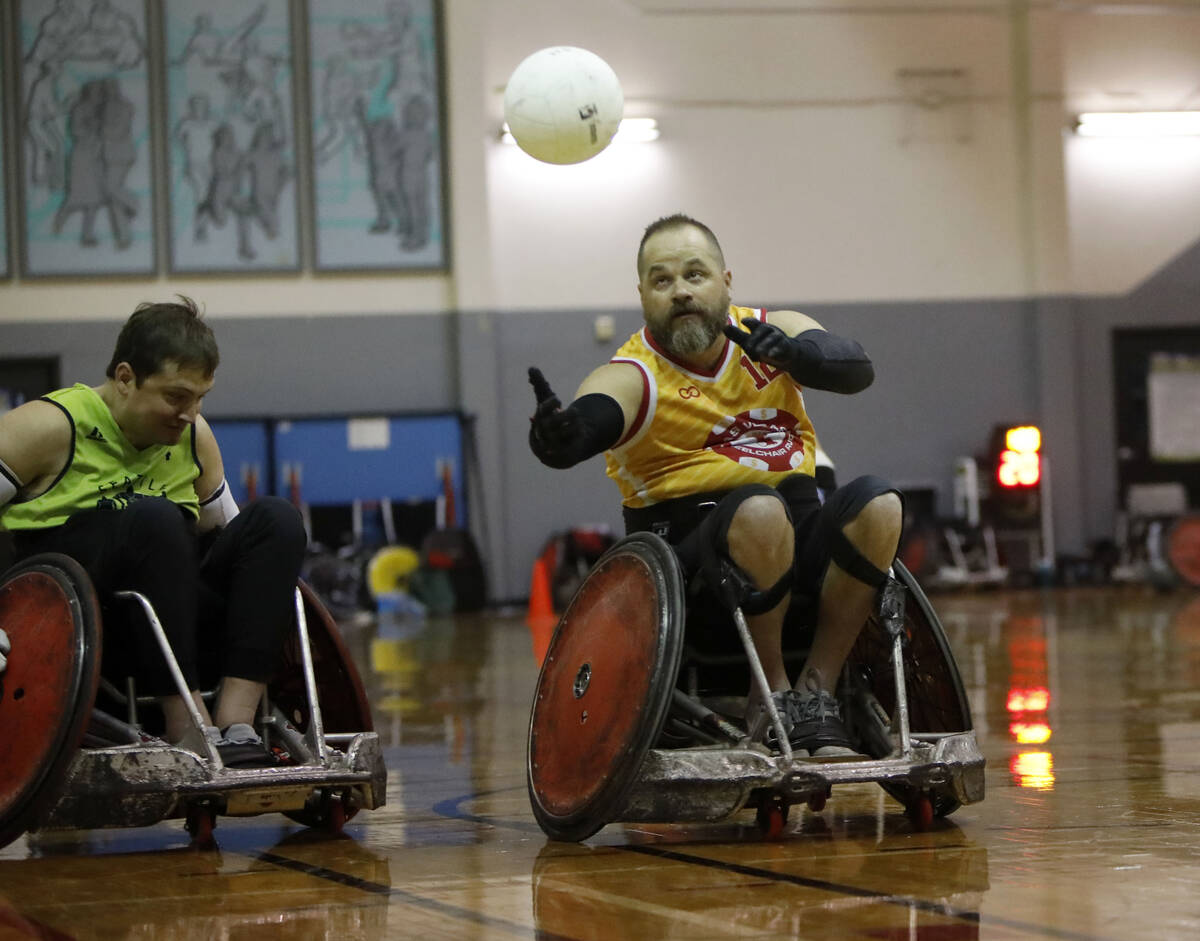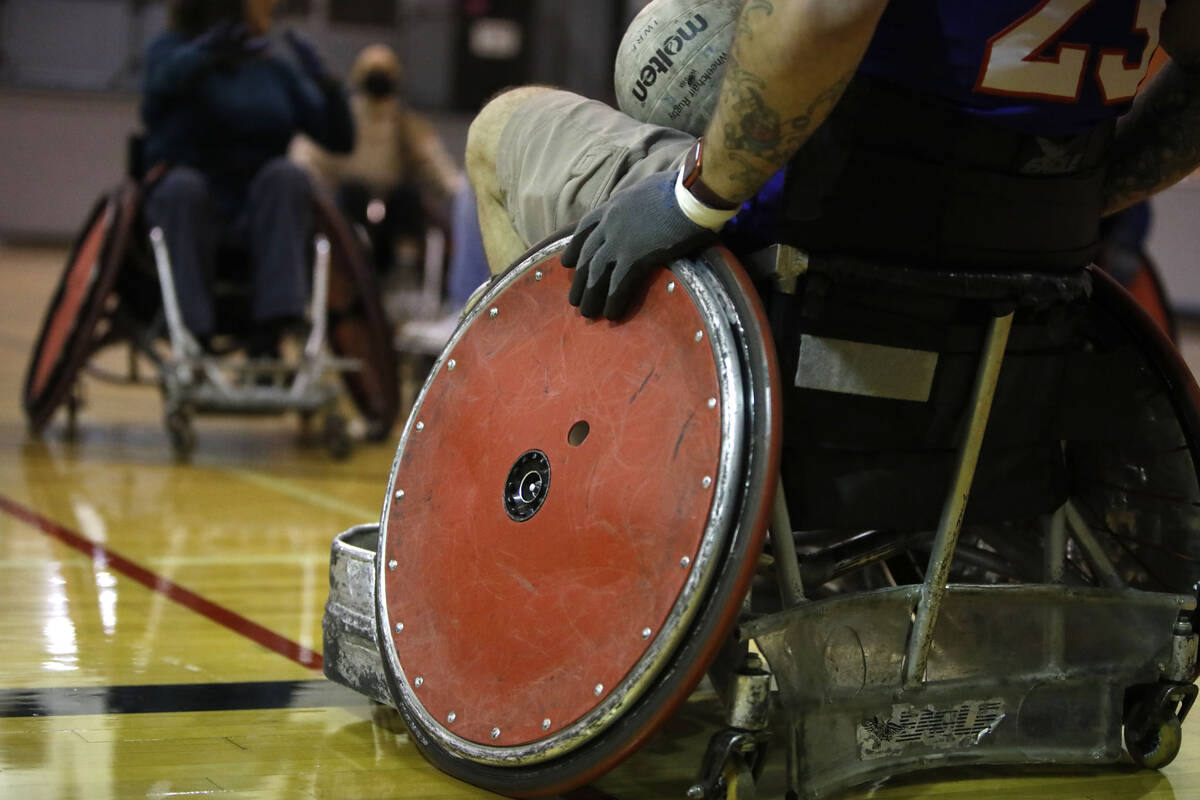Las Vegas wheelchair rugby team offers speed, contact, life lessons
It’s sometimes played on a basketball court, uses a volleyball, shares its name with rugby and seems a bit like soccer with, maybe, a smidgen of handball thrown in.
But what wheelchair rugby most feels like to a first-timer sampling the sport is riding an amusement park bumper car as a kid when your car gets stuck in a corner and you can’t get it out and some teenage ogre is speeding toward you on a collision course and you feel hopelessly and irredeemably trapped.
But Bradley Boe makes it look easy. He’s the founder of and a player with the Las Vegas High Rollers, a wheelchair rugby team that’s hosting “Vegas Vengeance” a tournament that started Friday and runs through Sunday at Dula Gym in downtown Las Vegas. Scheduled to join the High Rollers in the tournament were wheelchair rugby teams from Reno, Portland, Seattle, Phoenix and Grand Rapids, Mich.
Moviegoers were introduced to the controlled mayhem of wheelchair rugby through the Oscar-nominated 2005 documentary “Murderball.” And while it isn’t a sport followed by most sports fans, wheelchair rugby incorporates elements they’d love, including speed, contact and high scoring, plus an imperative that is wheelchair rugby’s own: Don’t flip over.
The basics
The Las Vegas High Rollers was formed during the summer of 2018, Boe says, and “our first season started Sept. 1, 2018. At that point we were still a developmental team. We did that for three years.”
Now the High Rollers is a full-fledged, official, nationally ranked team, he says, and will “probably go to national championships this year for, really, our first official season.”
The sport was developed by quadriplegic athletes in Canada during the ’70s, according to the International Paralympic Committee. It was unveiled as a demonstration sport during the 1996 Atlanta Paralympic Games and became a medal sport at the 2000 Sydney games.
Wheelchair rugby typically is played on a basketball court or in a gym by players sitting in squat, low-riding wheelchairs with angled wheels and stubby frames that look like they’ve been in a three-car pile-up. Those wheels provide at least some measure of stability and even can help a moving player to almost magically scoop up a ball from the ground into the player’s hand as the player uses his other hand to guide the chair.
“We’re all quads, so none of us have any finger function,” Boe explains, and the angled wheels also help keep a ball from going under the chair.
Not quite rugby
The oddest thing about wheelchair rugby is that it actually “has little or no resemblance to able-bodied rugby,” Boe says. “It was invented by hockey players in Canada, so there are a lot more similarities to hockey and a little bit of soccer and basketball mixed in.”
Points are scored when players — four per team are on the court at once — move the ball past the opponent’s goal line, and the ball has to be bounced or passed at least once every 10 seconds while in play.
“It’s high-scoring, really fast and very audience-friendly if you’ve never seen it before,” Boe says. “The other thing is, we play indoors with full-metal wheelchairs and there’s a lot of contact. So we are hitting each other in these little metal tanks and it gets really loud.
“We’ll flip over, too, quite frequently. We’ll have people screaming in the audience, taken aback by that.”
Running into other players’ chairs even is part of the game’s strategy — chairs used by defenseman are equipped with protruding footrests called pickers that are designed to tangle up an offensive player’s chair — but, Boe says, “people think we’re being mean.”
Flipping over is “not as bad as you think,” he says. “It’s loud, but you’re pretty encased in (the chair). Flipping over in my everyday chair hurts a lot more than flipping over in this.”
Players are classified on the basis of their physical function, receiving point values ranging from 0.5 to 3.5 in increments of 0.5. The total value among the four players a team has on the court at one time can’t be greater than 8. So, Boe says, even that can become part of the game’s strategy in that “you want the best lineup you can.”
To a newcomer, the game might appear to be random and unsophisticated. But, says High Rollers player-coach Austin Cogar, “once you start understanding the game, then it starts to unfold in front of you, and you’re, like, ‘Oh, I see exactly why he’s sitting out there.’ “
“To the average viewer it can look a lot like demolition cars out there,” says Cogar, 32, who started playing wheelchair rugby a few months after a car crash at age 17 left him a C-5, C-6 quadriplegic. “But once you get to know this sport, this is one of the most intricate, demanding — mentally and physically — (games) a sport can be.”
An introduction
Boe, now 29, was 22 when, during a visit to Lake Tahoe with friends, “I dove into Lake Tahoe and broke my neck and became a C-4, C-5 quadriplegic.”
He had played sports during high school and wrestled for three years while attending the U.S. Merchant Marine Academy. After being injured, he transferred to UNLV, graduated in December 2021 with a degree in kinesiology, and recently was offered a position as a case manager at a local rehabilitation hospital.
His introduction to wheelchair rugby came during his own rehab, when he saw “Murderball.”
“I enjoyed it. It inspired me,” he says. “And it was just hilarious. Those guys’ personalities just cracked me up, and I fell in love with the sport from there.”
Boe admits that when a counselor first approached him during rehab and told him about wheelchair sports, “I think the first thing I said to her was, ‘Wheelchair sports, that’s cute.’ I didn’t really go the first time. I was stupid.”
He was surprised to discover that wheelchair rugby was “a little more intense than I thought at first.” Now that intensity and the sport’s competitiveness are two of the things he finds appealing.
Another is the camaraderie with other players. “There are very few moments when you’re around a bunch of other guys in the same exact circumstances you are,” Boe explains, and, through wheelchair rugby, there’s now at least “one day a week when I can … be around my peers.”
“I have friends in almost every state because of this sport,” Boe says. When traveling to tournaments, it’s not unusual to “end up couch-surfing sometimes. You know the guy’s house is going to be (wheelchair) accessible. You don’t know if a hotel is going to be accessible.”
Cogar says playing wheelchair rugby “built my confidence in my ability to just do things.”
He enjoys introducing newcomers to the sport and seeing how it helps them, too. They “get better at the sport,” Cogar says, but also learn “a lot about life skills. There’s a lot more going on (about) growing in life which, honestly, is the more important part.”
Outreach
Boe also has created a nonprofit organization, the High Rollers Adaptive Sports Foundation (high-rollers-foundation.org), to serve as the team’s booster club and provide mentoring and outreach into the community.
“The most insane thing about the sport is the cost,” Boe says. A chair can cost $8,500, and the costs of playing can be prohibitive to someone already dealing with medical bills and other injury-related expenses.
Boe credits wheelchair rugby with changing his perceptions about what he could accomplish after being injured and suspects it can change spectators’ perceptions, too.
“We’ve had someone come straight out of rehab (saying) ‘I can do that? I didn’t know,’ ” he says.
“It can change your own perception about yourself. I’d have to imagine it changes other people’s perceptions, as well.”
Contact John Przybys at reviewjournal.com. or 702-383-0280. Follow @JJPrzybys on Twitter.











































